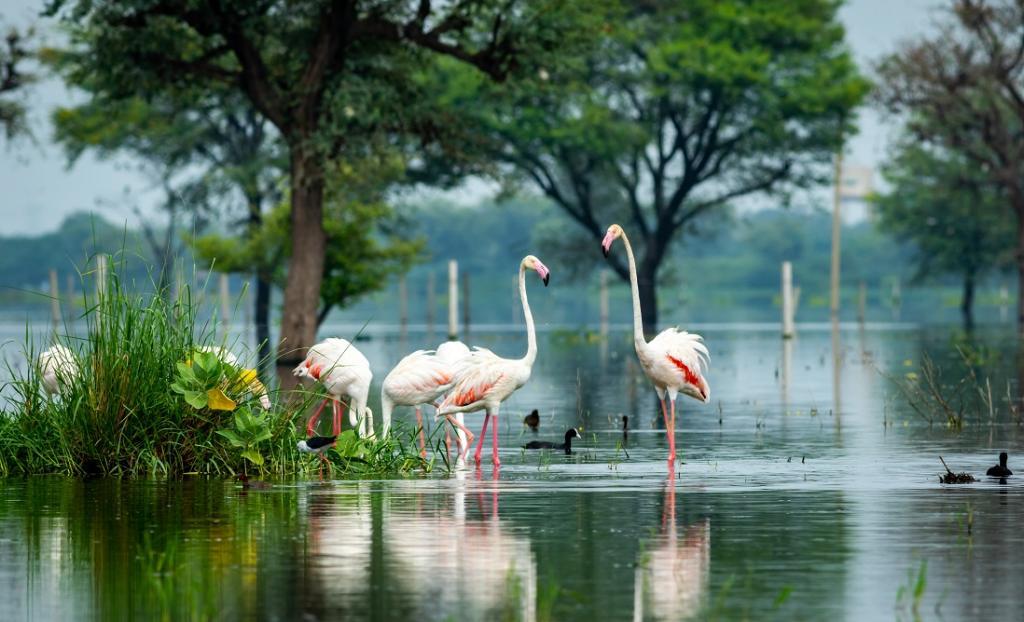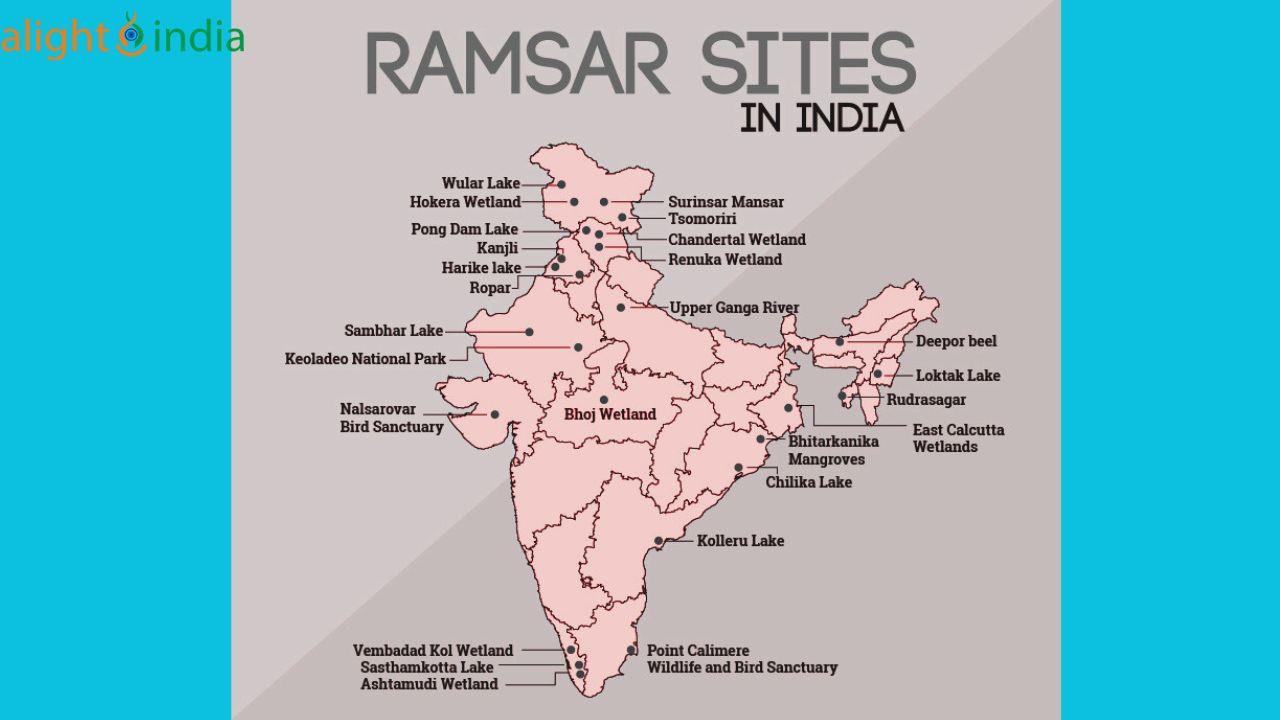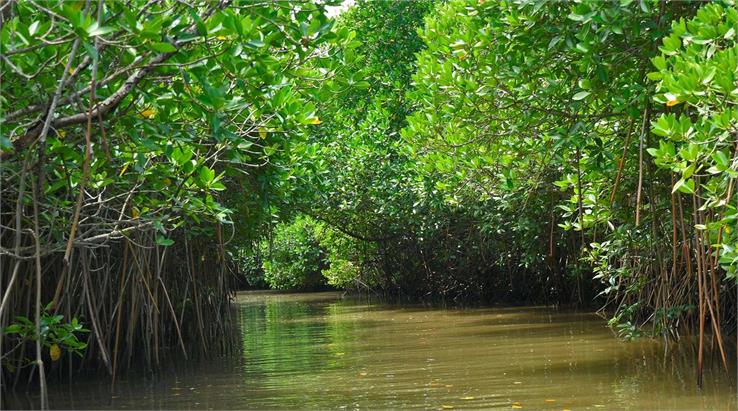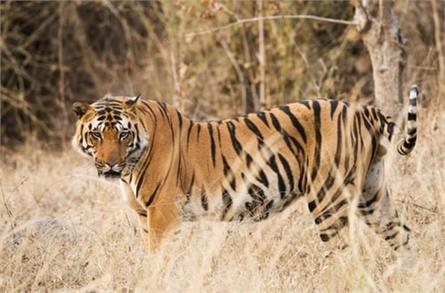List of 75 Ramsar Sites in 2023, India!

Ramsar sites are truly invaluable ecosystems that have been designated under the Ramsar Convention. They are essential for ensuring sustainable development, conserving biodiversity, and promoting the well-being of local communities. These sites are characterized by their ecological significance, which is why they are important to us.
Ramsar sites are named after the city of Ramsar in Iran, where the Ramsar Convention was signed. The Ramsar Convention is an international treaty that was signed in 1971. It aims to protect wetlands and promote their wise use, recognizing that wetlands are essential to the global ecosystem. Ramsar sites have been designated under this convention and are recognized as some of Earth's most valuable and significant wetland ecosystems.
Ramsar sites are essential for many reasons. They play a crucial role in conserving biodiversity and providing habitats for various plant and animal species. They also help protect against floods and droughts, which are becoming increasingly common due to climate change. Furthermore, these sites are essential for human well-being, providing food, clean water, and other resources.
1. Understanding Ramsar Sites

1.1 The Ramsar Convention
The Ramsar Convention, signed in 1971, is an international treaty to protect and conserve wetlands globally. Its main objective is to halt the loss and degradation of wetlands, promoting their wise use and sustainable management.
1.2 Criteria for Ramsar Sites Designation
To be designated as a Ramsar site, a wetland must meet specific criteria, including ecological significance, biodiversity value, and its role in sustaining local communities. This ensures that only the most extraordinary wetlands receive Ramsar status.
2. Ecological Significance of Ramsar Sites
2.1 Biodiversity Hotspots
Ramsar sites host abundant plant and animal species, making them biodiversity hotspots. These wetlands provide habitat for various rare and endangered species, playing a critical role in their conservation.
2.2 Migratory Bird Habitats
Many Ramsar sites serve as stopovers and breeding grounds for migratory birds. These wetlands provide millions of birds' crucial resting and feeding areas during their long-distance journeys.
2.3 Ecosystem Services
Ramsar sites offer a wide range of ecosystem services. They act as natural water filters, regulate floods, recharge groundwater, and provide natural resources like fish and water for agriculture. Additionally, wetlands sequester carbon, contributing to climate change mitigation.
List Of Ramsar Sites In India 2023 With Detailed Information
How many Ramsar Sites In India?
There are currently 75 Ramsar sites in India. These sites are wetlands considered "international importance" under the Ramsar Convention. Wetlands in India face numerous threats, such as loss of vegetation, salinization, water pollution, invasive species, and excessive development. Tamil Nadu has the highest number of Ramsar sites in India, with 14 locations. Since 2014, 49 new Ramsar sites have been added across India, including places like Karikili Bird Sanctuary, Pichavaram Mangrove, and Pallikaranai Marsh Reserve Forest. The total surface area covered by Ramsar sites in India is approximately 1,083,322 hectares. The total list of Ramsar sites in 2022 was also seventy-five.
Here is a list of total Ramsar Sites in India, along with their locations:
|
75 Ramsar Sites in India |
||||
|
Serial No. |
Ramsar Site |
Location |
Year of Designation |
Area |
|
1. |
2002 |
40 km² |
||
|
2. |
2002 |
901 km² |
||
|
3. |
2020 |
26.2 km² |
||
|
4. |
2022 |
0.42 km² |
||
|
5. |
2021 |
6.05 km² |
||
|
6. |
2012 |
123 km² |
||
|
7. |
2021 |
6.99 km² |
||
|
8. |
2021 |
10.38 km² |
||
|
9. |
2021 |
4.11 km² |
||
|
10. |
2021 |
142.5 km² |
||
|
11. |
2005 |
0.49 km² |
||
|
12. |
2002 |
156.62 km² |
||
|
13. |
2005 |
0.2 km² |
||
|
14. |
2022 |
5.18 km² |
||
|
15. |
2002 |
614 km² |
||
|
16. |
2002 |
3.73 km² |
||
|
17. |
1905 |
1512.5 km² |
||
|
18. |
2002 |
32 km² |
||
|
19. |
2022 |
2.48 km² |
||
|
20. |
Sirpur wetland |
2022 |
1.61 km² |
|
|
21. |
Yashwant Sagar |
2022 |
8.22 km² |
|
|
22. |
Lonar Lake (Impact Crater Lake) |
2020 |
4.27 km² |
|
|
23. |
Nandur Madhameshwar |
2019 |
14 km² |
|
|
24. |
Thane Creek |
2022 |
65.21 km² |
|
|
25. |
Loktak Lake |
1990 |
266 km² |
|
|
26. |
Pala Wetland |
2021 |
18.5 km² |
|
|
27. |
Ansupa Lake |
2021 |
2.31 km² |
|
|
28. |
Bhitarkanika Mangroves |
2002 |
650 km² |
|
|
29. |
Chilika Lake (Oldest and 1st Ramsar Site in India) |
1981 |
1165 km² |
|
|
30. |
Hirakud Reservoir |
2021 |
654 km² |
|
|
31. |
Satkosia Gorge |
2021 |
981.97 km² |
|
|
32. |
Tampara Lake |
2021 |
Three km² |
|
|
33. |
Beas CnR |
2019 |
64 km² |
|
|
34. |
Harike Wetland |
1990 |
41 km² |
|
|
35. |
Kanjli Wetland |
2002 |
1.83 km² |
|
|
36. |
Keshopur-Miani CmR |
2019 |
34 km² |
|
|
37. |
Nangal Wild Life Sanctuary |
2019 |
One km² |
|
|
38. |
Ropar Wetland |
2002 |
13.65 km² |
|
|
39. |
Keoladeo National Park (1st wetland added to Ramsar site list) |
1981 |
28.73 km² |
|
|
40. |
Sambhar Lake |
1990 |
240 km² |
|
|
41. |
Chitrangudi Bird Sanctuary |
2021 |
2.6 km² |
|
|
42. |
Gulf of Mannar Marine |
2022 |
526.72 km² |
|
|
43. |
Kanjirankulam Bird Sanctuary |
2022 |
0.96 km² |
|
|
44. |
Karikili Bird Sanctuary |
2022 |
0.584 km² |
|
|
45. |
Koonthankulam Bird Sanctuary |
2021 |
0.72 km² |
|
|
46. |
Pallikaranai Marsh Reserve Forest |
2022 |
12.475 km² |
|
|
47. |
Pichavaram Mangrove |
2022 |
14.786 km² |
|
|
48. |
Point Calimere Wildlife Sanctuary & Bird Sanctuary |
2002 |
385 km² |
|
|
49. |
Suchindram Theroor Wetland Complex |
2022 |
0.94 km² |
|
|
50. |
Udhayamarthandapuram Bird Sanctuary |
2022 |
0.44 km² |
|
|
51. |
Vaduvur Bird Sanctuary |
2022 |
1.12 km² |
|
|
52. |
Vedanthangal Bird Sanctuary |
2022 |
0.4 km² |
|
|
53. |
Vellode Bird Sanctuary |
2022 |
0.77 km² |
|
|
54. |
Vembannur Wetland Complex |
2022 |
0.2 km² |
|
|
55. |
Rudrasagar Lake |
2005 |
2.4 km² |
|
|
56. |
Hokera Wetland |
2005 |
13.75 km² |
|
|
57. |
Hygam Wetland |
2022 |
8.02 km² |
|
|
58. |
Shallbugh Wetland |
2022 |
16.75 km² |
|
|
59. |
Surinsar-Mansar Lakes |
2005 |
3.5 km² |
|
|
60. |
Wular Lake |
1990 |
189 km² |
|
|
61. |
Tso Kar (High Altitude Ramsar Site) |
UT of Ladakh |
2020 |
95.77 km² |
|
62. |
Tsomoriri (High Altitude Ramsar Site) |
UT of Ladakh |
2002 |
120km² |
|
63. |
Bakhira Wildlife Sanctuary |
2021 |
28.94km² |
|
|
64. |
Haiderpur Wetland |
2021 |
69 km² |
|
|
65. |
Nawabganj Bird Sanctuary |
2019 |
2 km² |
|
|
66. |
Parvati Arga Bird Sanctuary |
2019 |
7 km² |
|
|
67. |
Saman Bird Sanctuary |
2019 |
5 km² |
|
|
68. |
Samaspur Bird Sanctuary |
2019 |
8 km² |
|
|
69. |
Sandi Bird Sanctuary |
2019 |
3 km² |
|
|
70. |
Sarsai Nawar Jheel |
2019 |
2 km² |
|
|
71. |
Sur Sarovar (Keetham Lake) |
2020 |
4.31 km² |
|
|
72. |
Upper Ganga River (Brijghat to Narora) |
2005 |
265.9 km² |
|
|
73. |
Asan Barrage |
2020 |
4.44 km² |
|
|
74. |
East Kolkata Wetlands |
West Bengal |
2002 |
125 km² |
|
75. |
Sundarban Wetland (Largest Ramsar Site in India) |
West Bengal |
2019 |
4230 km² |
What are the threats to these wetlands?
The main threats to wetlands in India include:
1. Loss of vegetation
Wetlands are often subjected to deforestation and land conversion for agriculture, infrastructure development, and urbanization. This leads to the loss of diverse plant species and disrupts the ecological balance of the wetland.
2. Salinization
Excessive irrigation and water abstraction in nearby areas can lead to an increase in salinity levels in wetlands. This affects water quality and makes it inhospitable for many species, including aquatic plants and animals.
3. Water pollution
Pollution from industrial discharge, agricultural runoff, and domestic waste can severely impact the health of wetlands. Contaminants like heavy metals, chemicals, and nutrients can disrupt the delicate balance of the ecosystem and harm fish, birds, and other wildlife.
4. Invasive species
Non-native plant and animal species can invade wetlands and outcompete native species for resources. Invasive species can alter the structure and function of wetland ecosystems, leading to a decline in biodiversity.
5. Excessive development and road building
Construction activities in and around wetlands can disrupt the hydrological regime and destroy important habitats. It also leads to the fragmentation of wetland ecosystems, making them more vulnerable to other threats.
Protecting and conserving wetlands is crucial as they provide a wide range of ecosystem services, including flood control, water purification, carbon sequestration, and habitat for various plant and animal species.
Various Efforts to conserve wetlands
Efforts are being made to conserve wetlands in India through various initiatives and organizations. Here are some notable efforts:
1. Ramsar Convention
India is a signatory to the Ramsar Convention, an international treaty for the conservation and sustainable use of wetlands. Ramsar sites in India receive protection and management measures to preserve their ecological integrity.
2. National Wetland Conservation Program
The Ministry of Environment, Forest and Climate Change (MoEFCC) has implemented the National Wetland Conservation Program to protect and restore wetlands across the country. It focuses on the assessment, monitoring, and management of wetlands.
3. State Wetland Authorities
Several states in India have established State Wetland Authorities to oversee the conservation and management of wetlands at the state level. These authorities work towards identifying, protecting, and restoring wetlands through collaboration with local communities, government agencies, and NGOs.
4. Wetland Rules and Regulations
The Ministry of Environment, Forest & Climate Change (MoEFCC) has formulated Wetland Rules to regulate activities in wetland areas and prevent their degradation. These rules aim to safeguard wetlands from encroachments, pollution, and unsustainable development.
5. Community Participation
Many conservation initiatives involve local communities in the decision-making process and management of wetlands. Engaging communities helps in raising awareness, promoting sustainable practices, and ensuring the long-term conservation of wetland ecosystems.
6. Scientific Research and Monitoring
Ongoing scientific research and monitoring programs help in better understanding the dynamics of wetland ecosystems and assessing their health. These studies provide valuable data for policy formulation and conservation planning.
Efforts to conserve wetlands in India are crucial as they play a vital role in water purification, flood control, carbon sequestration, and supporting rich biodiversity. By implementing conservation measures and raising awareness, India aims to protect and sustainably manage its wetlands for future generations.
Are Local Communities Involved?
Yes, local communities are actively involved in wetland conservation efforts in India. Engaging communities is an essential aspect of successful conservation. Here are some ways local communities contribute:
1. Community-based conservation initiatives
Local communities play a vital role in conserving wetlands through community-led initiatives. They actively participate in activities such as wetland restoration, habitat improvement, and biodiversity monitoring.
2. Sustainable livelihoods
Conservation projects often integrate sustainable livelihood opportunities for local communities. By providing alternative income sources like eco-tourism, sustainable fishing, or handicraft production, communities are incentivized to protect wetlands and their resources.
3. Traditional knowledge and practices
Local communities possess traditional knowledge about wetland ecosystems, including sustainable resource management practices. This knowledge is valuable in guiding conservation strategies and ensuring the long-term sustainability of wetlands.
4. Awareness and education
Community involvement includes raising awareness about the importance of wetlands and the threats they face. Local communities help spread education and encourage responsible behavior towards wetland ecosystems among residents and visitors.
5. Stakeholder engagement
Local communities actively participate in decision-making processes, working collaboratively with government agencies, NGOs, and other stakeholders to develop and implement wetland conservation plans.
The involvement of local communities is crucial for the success of wetland conservation efforts. Their deep understanding of the local ecosystems, along with their dedication and stewardship, contributes significantly to the sustainable management and protection of wetlands.
Various Sustainable Livelihoods that Benefit Local Communities
Local communities in wetland conservation in India are involved in various sustainable livelihoods. Some examples include:
1. Eco-tourism
Local communities can participate in developing and managing eco-tourism initiatives around wetlands. This can include providing guided tours, birdwatching activities, and cultural experiences for visitors.
2. Fishing and aquaculture
Sustainable fishing practices, such as using selective fishing gear and avoiding overfishing, can provide livelihood opportunities for local communities. Additionally, communities can engage in responsible aquaculture practices like fish farming in wetlands.
3. Handicraft production
Local communities can engage in traditional handicraft production using natural materials sourced from wetland ecosystems. It can include making woven products, pottery, or decorative items that highlight the unique biodiversity of wetlands.
4. Conservation-based agriculture
Local communities can adopt sustainable agricultural practices, such as organic farming or agroecology, that promote the conservation of wetland ecosystems. This can include growing native plant species or utilizing traditional farming techniques compatible with wetland conservation.
5. Wetland restoration and management
Local communities can be hired or trained to participate in restoration activities, such as planting native vegetation, removing invasive species, or maintaining water quality. This involves engaging in wetland management plans and activities.
These sustainable livelihoods not only provide economic benefits to local communities but also create a vested interest in the conservation of wetland ecosystems. Integrating local communities into wetland conservation efforts fosters a sense of ownership and stewardship, leading to more effective and long-term conservation outcomes.
Ramsar sites are an essential part of the global ecosystem. They provide numerous benefits, from conserving biodiversity to protecting us from natural disasters. It is important that we continue to recognize their importance and work towards their preservation and wise use.











